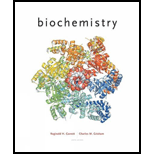
Concept explainers
To derive:
The expression of
Introduction:
The Arrhenius Law defines the activation energies and the rate constants of the reaction. The reactions can be of two types − catalyzed and uncatalyzed. In catalyzed reaction the presence of catalyst like enzymes reduce the activation energy and hence the reaction can be triggered at a lower energy level. In this question we are deriving an equation for catalytic power, that is, the ratio of catalyzed and uncatalyzed reactions.
Explanation of Solution
The catalyzed reaction is given as:
The equilibrium constant will determine the concentration of EX transition state which is given below:
The relation between free activation energy and equilibrium constant can be given by the following equation:
After substituting and simplifying the equations we get:
The above reaction was for catalyzed reactions. The reactions for uncatalyzed can be seen below:
Similarly, here the equilibrium constant determines the concentration of the X transition state as below:
The relation between free activation energy and equilibrium constant in this case can be given seen in the following equation:
Thus, simplifying the equations:
Hence, it can be considered that:
Want to see more full solutions like this?
Chapter 14 Solutions
Biochemistry
- Which type of enzyme catalyses the following reaction? oxidoreductase, transferase, hydrolase, lyase, isomerase, or ligase.arrow_forward+NH+ CO₂ +P H₂N + ATP H₂N NH₂ +ADParrow_forwardWhich type of enzyme catalyses the following reaction? oxidoreductase, transferase, hydrolase, lyase, isomerase, or ligase.arrow_forward
- Which features of the curves in Figure 30-2 indicates that the enzyme is not consumed in the overall reaction? ES is lower in energy that E + S and EP is lower in energy than E + P. What does this tell you about the stability of ES versus E + S and EP versus E + P.arrow_forwardLooking at the figure 30-5 what intermolecular forces are present between the substrate and the enzyme and the substrate and cofactors.arrow_forwardprovide short answers to the followings Urgent!arrow_forward
- Pyruvate is accepted into the TCA cycle by a “feeder” reaction using the pyruvatedehydrogenase complex, resulting in acetyl-CoA and CO2. Provide a full mechanismfor this reaction utilizing the TPP cofactor. Include the roles of all cofactors.arrow_forwardB- Vitamins are converted readily into important metabolic cofactors. Deficiency inany one of them has serious side effects. a. The disease beriberi results from a vitamin B 1 (Thiamine) deficiency and ischaracterized by cardiac and neurological symptoms. One key diagnostic forthis disease is an increased level of pyruvate and α-ketoglutarate in thebloodstream. How does this vitamin deficiency lead to increased serumlevels of these factors? b. What would you expect the effect on the TCA intermediates for a patientsuffering from vitamin B 5 deficiency? c. What would you expect the effect on the TCA intermediates for a patientsuffering from vitamin B 2 /B 3 deficiency?arrow_forwardDraw the Krebs Cycle and show the entry points for the amino acids Alanine,Glutamic Acid, Asparagine, and Valine into the Krebs Cycle - (Draw the Mechanism). How many rounds of Krebs will be required to waste all Carbons of Glutamic Acidas CO2?arrow_forward
 BiochemistryBiochemistryISBN:9781305577206Author:Reginald H. Garrett, Charles M. GrishamPublisher:Cengage Learning
BiochemistryBiochemistryISBN:9781305577206Author:Reginald H. Garrett, Charles M. GrishamPublisher:Cengage Learning
